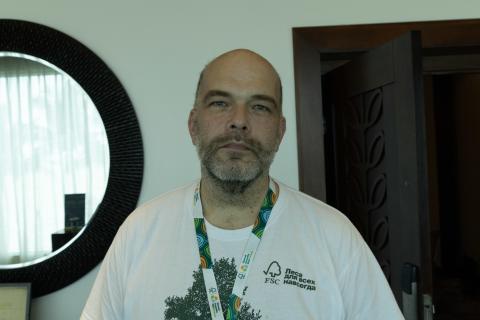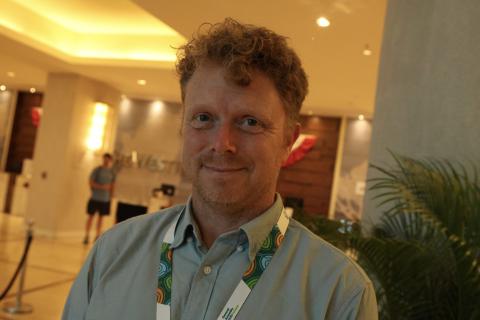FSC General Assembly 2011 - the overview
Learn what changes are in store in the FSC system and can catch up on key decisions by reading this summary of the FSC General Assembly held on 27 June -1 July.
FSC now has 27 new important tasks to carry out over the next three years. More than 400 representatives of the wood industries, forest experts, NGOs and certification bodies had gathered and engaged in lively discussions and negotiations in the days prior to the formal proceedings that led to this result.
Global democracy in practice
"This is a central event in the FSC system" says Peter Feilberg, CEO of NEPCon.
"People of all nationalities and representatives of all of FSC's three chambers - the environmental chamber, the social chamber and the economic chamber - come together for five days where they meet face to face in order to discuss a wide range of issues of importance to the FSC system. The fantastic thing is that it actually works", says Mr. Feilberg.
"Consensus has once again been achieved within a number of central areas, among stakeholders who have very different perspectives, but who do have a common interest - to make the FSC system work efficiently".
FSC has an elaborate system to safeguard democracy and equality between the three chambers and between the South and the North. The voting procedure follows strict rules with great focus on enabling stakeholders to present and argue for their points of view. After initial discussions on each motion, the audience even votes to decide whether to proceed with the voting or whether they need time for further discussion.
Simultaneous interpretation is offered in several languages, and that option is used frequently. Altogether 38 motions were up for voting, and 27 were approved by the members. "The event is a fascinating display of global democracy at work. It is happening right before your eyes", says Mr. Feilberg.
Below is a brief summary of some of the key decisions made during the assembly. You can find much more information, perspective and analysis in our six daily newsletters from the event.
The end of 'ISO-fication'?
A motion requesting FSC to focus on field performance was supported by all members present at the assembly. This voting marked a break with the 'ISO-fication' that has been visible in the system during past years, where FSC and its quality control organ Accreditation Services International (ASI) have focused increasingly on procedural and system requirements, based on a policy of alignment
with ISO's requirements.
This focus has inadvertently led to decreasing focus on the central idea of the FSC system: checking and verifying how forest management and traceability work in practice.
The members requested a clear focus on practice: a forest operation may have a plan for the protection of biodiversity, but is the plan implemented in the field? Certified companies need to have a chain of custody procedure - but are the employees aware of the procedure, is it properly understood by the relevant staff, and is it followed in practice?
Transparency: stakeholders to be engaged in FSC's core processes
Stakeholders voiced their concern about the lack of communication by FSC regarding how General Assembly decisions are followed up on.
Several organisations reported on cases where General Assembly decisions had not been followed by action or where the action had been inadequate or not according to the intent. The members supported a motion requiring FSC to involve and communicate more effectively with its stakeholders about the implementation of passed motions.
Another proposal also aimed to enhance the transparency of the system by making more of the contents in the certification assessment reports available to the public, thus enabling scrutiny by NGOs, researchers and others. The issue divided the economic chamber and did not pass.
The Controlled Wood system up for main repairs
A proposal to ensure better control with Controlled Wood was unanimously approved. Controlled Wood has played an important role in the expansion of FSC by providing an option for mixing non-certified wood into FSC-MIX products, on the condition that the non-certified wood is coming from aras where none of five defined forms of unacceptable activities are taking place. It is crucial for FSC's credibility that the Controlled Wood system works as intended - i.e. that it does in fact minimise the risk of highly controversial timber entering into the FSC supply chain.
However, research carried out by FSC itself and by Greenpeace has shown that there are serious flaws in the Controlled Wood system. For example, companies are using very different interpretations of the requirements for the Controlled Wood risk assessments which the companies need to carry out when sourcing from areas that can not be classified as 'low risk' for all of the risk categories.
The General Assembly decided to transfer the responsibility for the risk analyses from the companies to FSC. The members also voted to ask for several other actions that will strengthen the control over Controlled Wood. Proposals to phase out Controllled Wood over the long term were removed from the table during negotiations, as there was not sufficient support to this suggestion in the Economic Chamber.
FSC to meet legality requirements
The FSC system needs to offer maximum assurance that the products comply with legislation on timber legality applicable in the EU and the US and any future legislation in key markets such as Australia. That was the message from the gathered members.
In fact FSC is already well on its way to establish full alignment with key timber legality acts. One of the actions FSC has taken is to review the Controlled Wood system to seal any gaps with respect to EU legality requirements.
At a very well-attended seminar held during the event, FSC presented its promising plans for a new online traceability system, which will help secure legality as well as traceability of products all the way back to the country of oirigin - one of EU's requirements that forms a great challenge for many operators on the marketplace.
Consistent requirements for forest management
FSC's requirements need to be interpreted in a uniform way, when the global FSC standards are translated into local conditions by developing indicators for each global criterion.
In countries where there is no FSC-endorsed national FSC standard, certification bodies has done this by developing their own 'interim standards'. However, too much variation has occurred between different certification bodies' interim standards applicable in the same country.
For this reason, the members decided to transfer the responsibilty for interim standard development to FSC from the end of 2012.
Market development
It was decided that FSC shall establish closer collaboration with the retail and construction business sectors.
These sectors have a clear interest in FSC with respect to responsible sourcing of their timber products - and they also represent a huge potential for creating awareness of the FSC label among consumers as well as powerful buyer groups.
Small forest operations and indigenous peoples
It was decided to establish a committee which will explore how indigenous peoples may gain more influence and benefit more from the FSC system. Owners of small forest properties may also expect to get more attention from FSC. The members of FSC decided that more shall be done to facilitate their inclusion in the FSC system, partly though expanding their access to the so-called SLIMF rules permitting simplier and more streamlined certification procedures, and through training provided to forest owners and FSC auditors.
Climate change: carbon is an environmental aspect
FSC's members agreed that carbon sequestration should be regarded as a significant environmental aspect of forest management, and FSC will now work to integrate the aspect in the global principles and criteria for responsible forest management. Albeit with less unanimous support, the members also decided that FSC should explore whether natural ecosystems with exceptionally large carbon reserves - e.g. forests with peat bogs - should be classified as High Conservation Value Forest.
The special General Assembly editions of Certified Wood Update were published jointly by NEPCon and the Rainforest Alliance. They were sponsored or promoted by DLH, SIG, Triton Logging, Mongabay, Domtar, Durog Bag, Clearwater Paper, Imaflora and IDH. We are grateful for the generous support to our project. Also our warm thanks to FSC-Danmark, who took care of the design and daily layout of the print newsletter.



